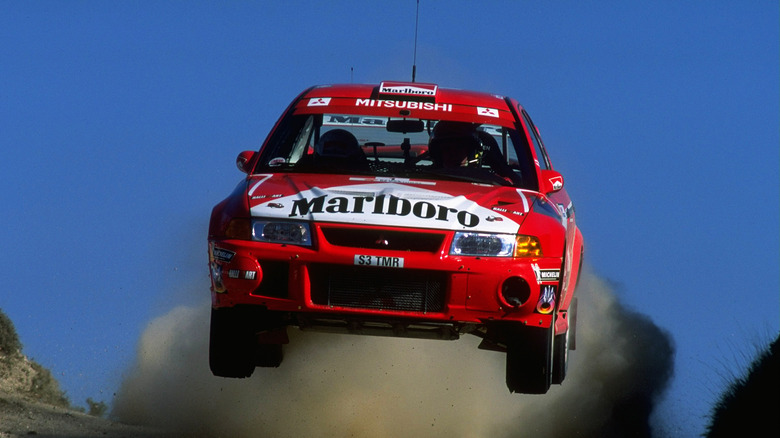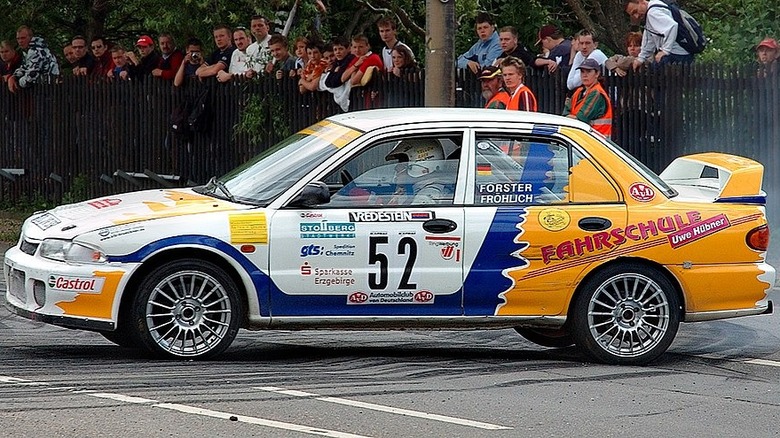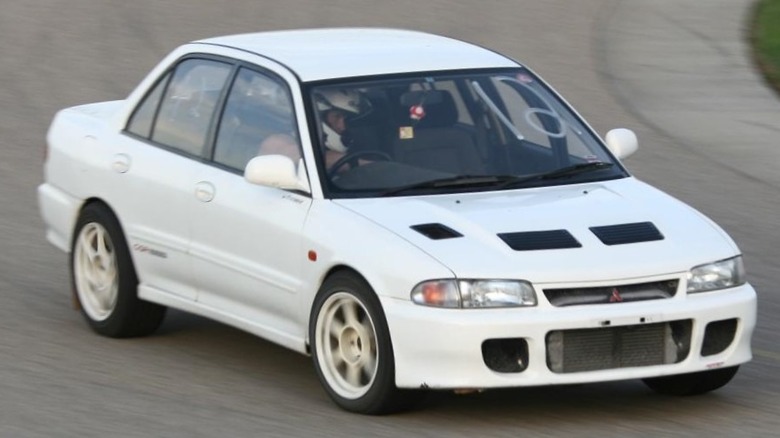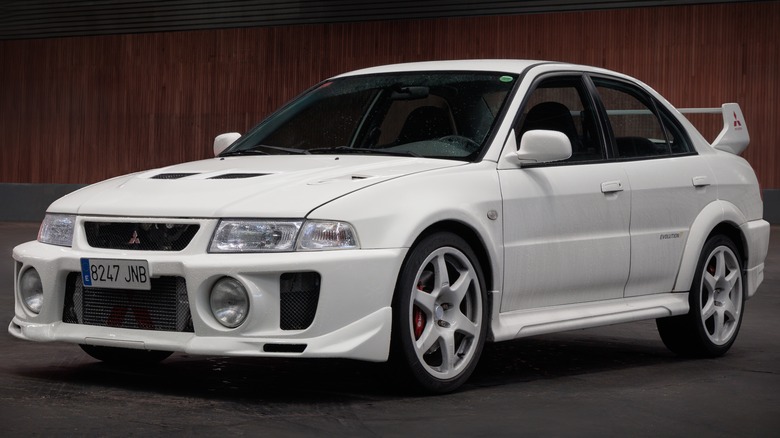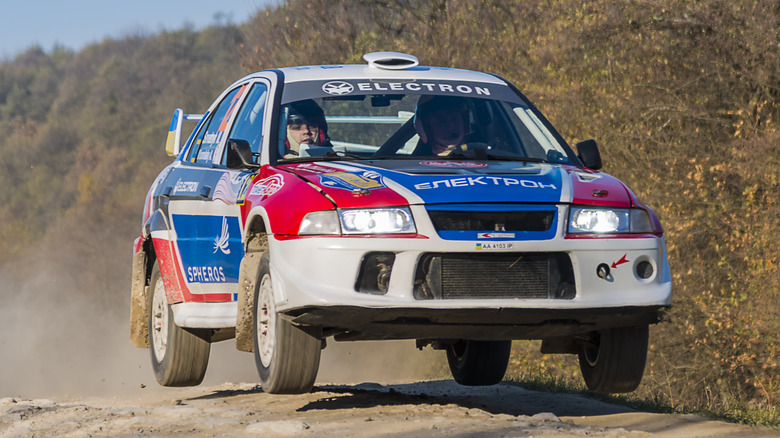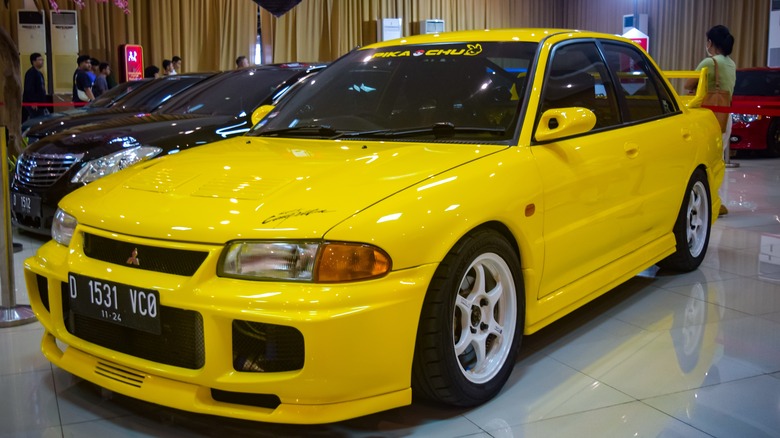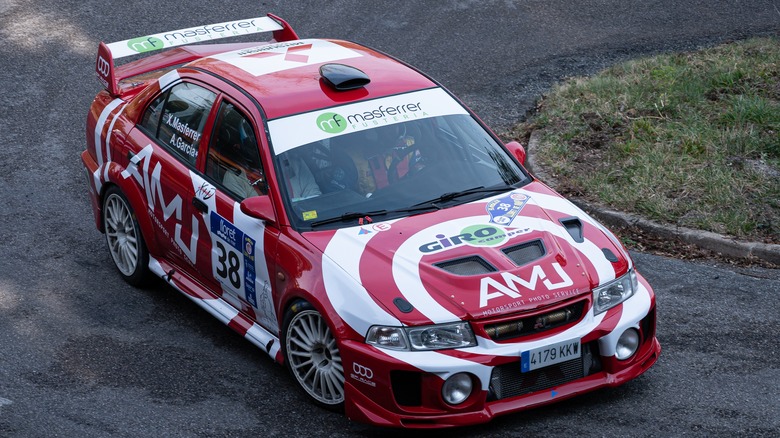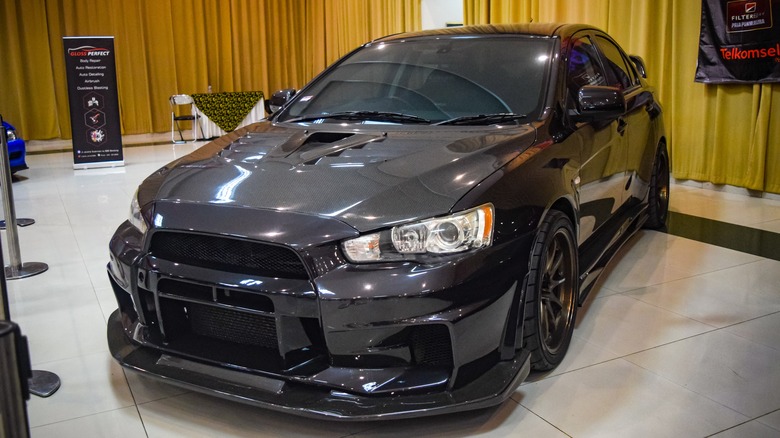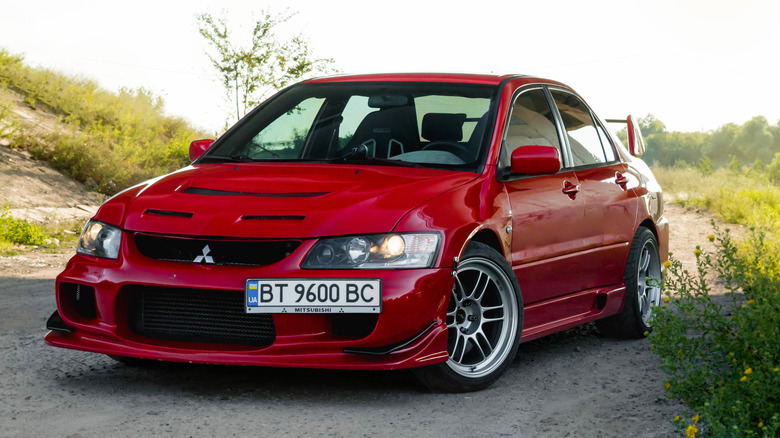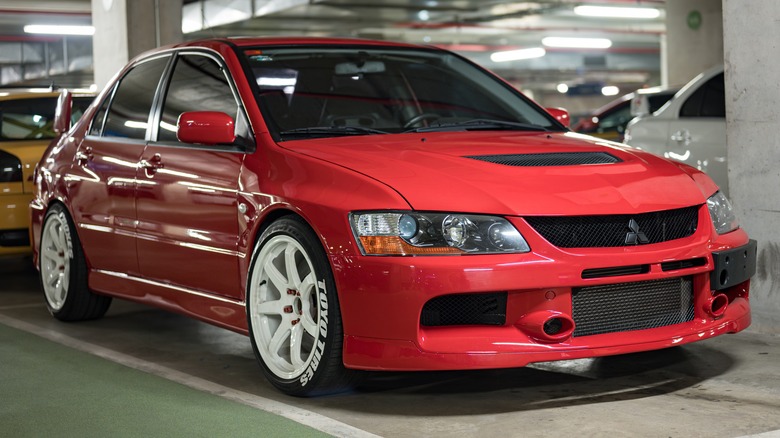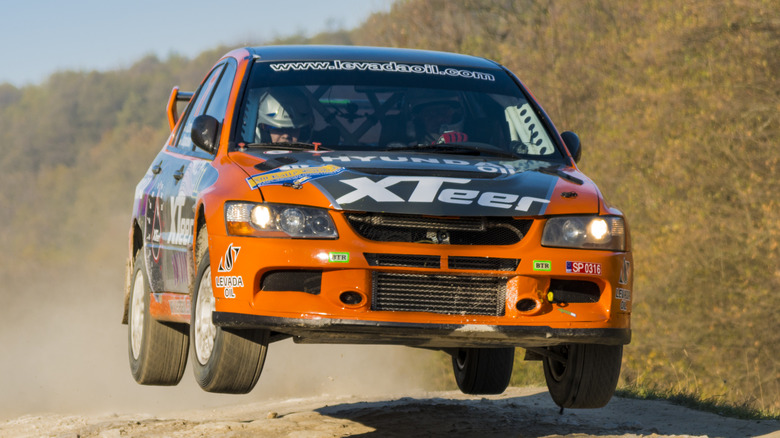Every Generation Of The Mitsubishi Lancer Evolution Ranked From Slowest To Fastest
Founded as a shipping company in 1870, Mitsubishi has built everything from air conditioners to semi-conductors. But one of the coolest things to emerge from the company's factories is its famed rally cars.
Mitsubishi introduced the rally-designed Lancer 1600GSR in 1973. The diminutive 1.6-liter five-speed met with instant success, sweeping the podium at the Australian Southern Cross rally that year. But that was just the beginning. The Lancer would continue to race for decades, keeping Mitsubishi in the rally game through the development of the Galant VR4, an all-wheel-drive mid-sized sedan with one of the most reliable Mitsubishi engines ever under the hood, the 2.0-liter turbocharged four-cylinder Mitsubishi 4G63T.
By the early '90s, rally racing had evolved. Design shifted away from the old school as tracks grew narrower, and the FIA altered the rules. Mitsubishi needed a fresh approach. Its answer was to take much of what made the Galant VR4 unique, wrap it up in a smaller package, and bring the Lancer name back to glory with the first Lancer Evolution.
Not only did the Evo win the hearts and minds of race fans, it became a bona fide cultural phenomenon, appearing in movies, video games, and atop rally podiums.
True to its name, the Evolution represented Mitsubishi's commitment to continuous improvement. With each passing year, the racing Lancer evolved, receiving numerous upgrades. This pursuit of perfection resulted in a legacy of championship-winning performance. Join us as we rank every generation of the Lancer Evolution from the slowest to the fastest, telling the story of one of the most legendary rally cars ever made.
10. Evolution II: 1994 to 1995 (112 mph)
While the second-generation Evolution may be the slowest on this list, its performance is still commendable. Only 0.2 seconds behind the next model, a difference that's negligible in the world of high-performance vehicles, the Evo II nonetheless demonstrated an improvement over the first generation on the rally course.
The legendary 4G63T turbocharged 2.0-liter four-cylinder engine powered the Evo II. Tweaked up to 250 horsepower, the Evo II was slightly more potent than its predecessor. However, the changes added a bit to the weight — the car tipped the scales at 2,756 pounds. That addition of the 56 pounds may be what landed the Evo II behind the Evo I for the slowest of the bunch. Though it achieved the same 112 mph top speed, it gets up to 62 mph in 5.3 seconds, just 0.2 seconds behind the Evo I.
However, rally racing is about more than raw power. Engineers tightened the suspension, lengthened the wheelbase from 98.4 inches to 98.8 inches, increased the wheel size, and upgraded the gearbox. The Evo II participated in the 1994 World Rally Championship (WRC), securing second place in Athens and third in New Zealand. The 1995 season was even better, with its first victory in Australia in September and a 1-2 finish in Sweden the following month. Mitsubishi was trending in the right direction with this Evo.
[Featured image by Andre Karwath via Wikimedia Commons | Cropped and scaled | CC BY-SA 2.5]
9. Evolution I: 1992 to 1994 (112 mph)
It should come as little surprise that the first-generation Evo is near the bottom of the speed hierarchy. The transition from the Galant VR4 was bound to come with some issues, and the oldest technology on this list will not perform as well as the up-to-date cars.
From this point on, the Evo represented Mitsubishi's flagship performance model, particularly in the rally world. The Japanese manufacturer had been absent from the World Rally Championship since the departure of the Lancer EX 2000 in 1987.
The Evo I Rally Sport (RS) was a no-frills, race-focused machine designed for those who prioritized performance over comfort. For those who desired a bit more luxury, the GSR trim offered power amenities, air conditioning, and even a radio!
With the legendary 2.0 liter, turbocharged 4G63 four-cylinder under the hood, the new rally racer provided drivers 250 horsepower at 6000 RPM and 228 lb-ft of torque at 3,000 RPM filtered through a five-speed manual transmission. Weighing in at about 2,700 pounds, the Evo I achieved a top speed of 112 mph — the same as the slower Evo II generation but got to 62 miles per hour a tick faster in 5.1 seconds.
The Evo I scored a pair of podiums in the 1993 World Rally Championship (WRC): third place in Athens and second in Birmingham. It was enough to prove Mistubishi was onto something with their new racer, and they wanted to stay on that track.
[Featured image by Grant.C via Wikimedia Commons | Cropped and scaled | CC BY-SA 2.0]
8. Evolution V: 1998 to 1999 (147 mph)
The late 1990s signaled an integral change at the heart of rally racing. A tragic and dangerous spate of accidents through the mid-1980s saw WRC's governing body, the FIA, seek to improve the sport's safety. The FIA introduced regulations that stiffened competition by creating the World Rally Car class in 1997. Intended to replace the former Group A class, the WRC class pulled more manufacturers into the sport by making it less technical, changing homologation rules, and increasing the required commitment for entrants.
Halfway through its existence (though that was unknown at the time), the Evo V is considered one of the significant refreshes of the Evo nameplate — Mitsubishi had already been planning for substantial changes before the rules changed. Upgraded engine management, an improved turbo intercooler, redesigned suspension, 17-inch tires, an adjustable rear wing, and better brakes are just some of the improvements the V received.
Adhering to Japanese power laws, Mitsubishi initially limited the output of the Evo V. However, with minimal modifications and proper dyno-ing, the model's power rating easily surpassed the official 276 to 280 horsepower and 275 lb-ft of torque, reaching over 300 hp without any issues. The Evo V boasts a top speed of 147 mph and can accelerate from 0 to 62 mph in just 4.7 seconds, showcasing some competent performance capabilities.
7. Evolution IV: 1996 to 1998 (147 mph)
By the time this revision came out, the Lancer Evo had already come a long way from the rough-and-ready track fighting spirit of the earliest generations. That's not to say the Evo IV could be called refined — nobody was going to confuse the steel wheels and uncomfortable seats for a Bentley — but it revved up where it counted.
As the rally-winner evolved, so did its sophistication. Mitsubishi introduced the revolutionary active yaw control. This system, unrelated to the car's power, could monitor the drivetrain, activating a hydraulic clutch that would send revolutions to the wheels that need them most. The result? A handling revolution that left enthusiasts intrigued and eager for more.
Unsurprisingly, active yaw control did not significantly improve straight-line or top-speed performance, which is how we rank this list. Though the faithful 463GT earned an enlarged intercooler, The Evo IV is on par with the V that came after and the III that preceded it, with a top speed of 147 mph and a 0-62 mph time of 4.4 seconds thanks to 280 hp and 260 lb-ft of torque.
From a non-racing perspective, the Evo IV was the model that began to capture the hearts of race fans. Previously, Evos were only available in Japan and were a hit among rally fans. However, the Evo IV made its global debut in the wildly popular 1997 racing game "Gran Turismo." The word spread like wildfire, and soon, the Evo was on its way to becoming a household name.
6. Evolution III: 1995 (149 mph)
If at first you don't succeed, try, try again. Except Mitsubishi had succeeded with the first two generations of the Lancer. Encouraged by that upward performance trend, the third time proved a charm for the Evo as well, and Mitsubishi hit its stride with the Evo III.
Mitsubishi race engineers achieved a significant leap in power with a new turbocharger (the trusty 4G63 2.0 liter remained unchanged) that gifted the Evo III an additional 20 horsepower to play with — a respectable increase from 250 to 270. While competitors like Subaru continued to present similar cars season after season, the Mitsubishi team delivered three redesigned cars in as many years. It became clear that Evolution was more than just a name.
Mitsubishi had already made a mark with the I and II, but the Evo III truly made a splash in the rally scene. Despite being the third generation, it nearly broke into the top half of this list regarding raw speed, edging out the IV by a mere two mph: top speed was 149 mph and a 0-62 mph time of 4.9 seconds. The Evo III's performance was not to be taken lightly.
The 1996 WRC season also saw the Finnish rally great Tommy Mäkinen slip behind the Ralliart racing Evo III wheel on his way to greatness. From cheap and uncomfortable seats in the spartan cockpit, Mäkinen roared to the driver's championship that year. People sat up and took notice; the Evo was on its way to rally greatness.
5. Evolution VI: 1999 to 2000 (150 mph)
At the turn of the century, rally was more popular than ever, and sponsor money flowed into the sport, raising the stakes for drivers and constructors alike. The "Gran Turismo" and "Fast and Furious" franchises were also invigorating the North American import market.
By this time, Tommy Mäkinen was angling for four straight championships. The Evo's reputation had gone worldwide. Not yet available in the United States, Mitsubishi offered it in Germany and Great Britain. It also produced a limited Tommy Mäkinen Edition Evo, which has been banned in the U.S. under import regulations, known to aficionados as the Evo 6.5, with a run of 2,000 built.
Evo VI was the final Lancer built on the old Group A homologation rules. An ever-larger intercooler was crammed under the hood and attached to the same ol' 4G63 turbo 2.0 liter; this time tweaked up to 280 horsepower and 275 lb-ft of torque. The VI weighed in at 2,998 pounds — significantly more from the earliest generations, but that power served it well, with a top speed of 150 mph and 0-62 mph time of 4.4 seconds.
Some consider the Evo VI to be the ultimate expression of the Evo. It was a pure race machine, yet to receive much in the way of comfort upgrades. For the 1999 WRC season, the Evo VI saw no fewer than seven podiums on its way to Mäkinen's fourth driver's championship.
4. Evolution X: 2007 to 2016 (150 mph)
Few suspected when Mitsubishi crammed the VR-4 into a smaller body, the resulting car would become a proven champion and worldwide craze. The Evolution X ultimately saw 10 years of production, effectively a victory lap, before ceasing production in 2016.
As market dynamics changed, so did the Evolution. Mitsubishi responded to the growing consumer demand for comfort for the final version of the Evo. The Evo X was not a bare-bones, uncomfortable speed machine like some predecessors. It now boasted the amenities of a 2010-era commuter, including infotainment screens with navigation, a premium sound system, and a dashboard with LCD screens.
Mitsubishi even controversially dropped its tried and true powerplant in favor of a turbocharged 2.0 liter 4B11T. Pretty similar on paper, the 4B11T produced the highest horsepower numbers seen under a stock Evo hood with 295 at 6,500 RPM and 270 lb-ft of torque. The upshot is the second fastest Evo ever, with a 150 mph top speed and 0 to 62 mph speed of 6.3 seconds.
3. Evolution VIII: 2003 to 2005 (152 mph)
The United States was electrified with Evo fever in 2003, as Mitsubishi offered this generation of rally champion in the American market for the first time. The Subaru WRX had paved the way for success the previous year, and Mitsubishi finally joined the action in North America.
The VIII's subdued styling belies a powerful sedan. For the first time, it was available with a six-speed manual, which allowed the turbo 4G63T to run a little harder (racing VIIIs stuck with the five-speed). The upgraded gearbox and active differentials increased overall performance but also increased the weight to 3,109 pounds.
Mitsubishi did not participate in the 2003 WRC, but the Evo VIII remained in essentially the same shape for 2004 and 2005. The car may have taken a year off to explore Hollywood. The previous year, Paul Walker thrashed an Evo VII for the film "2 Fast 2 Furious," heightening the tuner fever many young car enthusiasts (the author included) were undergoing at the time. "Gran Turismo 3" added fuel to the fire with a gaggle of Evos gamers could race on the world's tracks. The VII cannonballed into the American consciousness, and the VIII splashed into its markets.
Despite not initially going racing, the Evo VIII was certainly no slouch. An estimated 265 hp at 3,500 RPM and 262 lb-ft of torque at 3500 RPM drove it to a top speed of 152 mph and 0 to 62 mph time of 6.1 seconds.
2. Evolution IX 2005 to 2007 (152 mph)
Though mechanically similar to its predecessor, including a recycled chassis, some changes under the hood boosted the Evo IX's horsepower. Mitsubishi's variable valve timing on the intake side of the engine, an upgrade to the turbo impeller, and improvements to belts and piston rings squeezed a spare 10 to 15 horsepower out of the workhorse 4G63 to the 280 hp range. Mitsubishi also introduced launch control, which helped rein in all those horses and likely contributed to the IX being the third fastest straight-line Evo on our list.
The massive rear spoiler was adjustable, helping the car squat over the rear wheels, and a functional hood scoop added some pizzazz to the exterior lines. Mitsubishi also finally gave a little love to the interior, adding faux carbon fiber dash accents, aluminum pedals, Recaro seats, and a reinvigorated dash cluster.
Overall, the IX scores a second-place finish on our list of fastest Evos, with a top speed of 152 mph and a 0-62 time of 5.7 seconds. Now wildly popular with the tuner crowd worldwide, the Evo IX was available in a plethora of trims and options, including the U.S. model Standard, Rally Sport, Special Edition, and Mitsubishi Racing (MR) trim, and even a bonus wagon edition only sold in Japan.
1. Evolution VII: 2000 to 2003 (157 mph)
The Evo VII takes the top spot on our list. It hit the peak of the Evo revolution as Mitsubishi was coming off rally success entering the new millennium. It's fitting since not only is this Evo faster than the others, but it's also the one that really brought the Lancer into the limelight. With a starring role in "2 Fast 2 Furious" (thanks to some promotional money from Mitsubishi), the Evo VII represents the center of the car's reputational Venn diagram between rally success and pop-culture presence.
Unassuming, if not for the enormous wing and Brembo brake calipers peeking out from behind the wheels, the Evo VII boasted nearly a decade of development in its Active Yaw Control, anti-lock brakes, and computerized differentials. The race-trim RS remained sports-oriented with its steel wheels, but the GSR trim was more comfortable, with air conditioning and a sound system. Mitsubishi burst into the 21st century with a variable all-wheel drive system suitable for snow, pavement, or gravel driving.
Though a car's sum is much more than its straight-line speed, it is appropriate that the Evo VII takes our top slot. The faithful 4G63 put out 280 hp and 282 lb-ft of torque, driving the lucky Evo VII to a top speed of 157.2 mph and a 0 to 62 time of 4.8 seconds.
